News and Resources
IRA Investors Are Concentrated in Lower-Cost Mutual Funds

Individual retirement accounts (IRAs) represent the largest share of assets in the US retirement market, with assets totaling $8.7 trillion at year-end 2018 (Figure 1). Forty-six percent of this total is held in mutual funds, with IRA mutual fund investors primarily invested in equity funds.
Figure 1
Forty-Six Percent of IRA Assets Are Invested in Mutual Funds
Percentage of assets, 2018
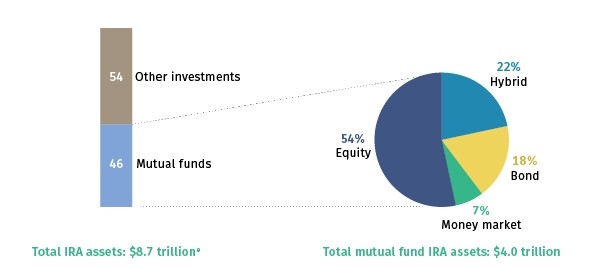
e Data are estimated
Sources: Investment Company Institute and Federal Reserve Board
As part of ICI’s ongoing efforts to shed light on important insights into IRA investing, ICI is updating its analysis of expense ratios that investors pay on mutual funds in their IRAs.
Like other mutual fund investors, IRA mutual fund investors incur expenses and fees that cover the costs of investing in mutual funds. ICI uses asset-weighted average expense ratios to measure the expense ratios that mutual fund investors actually incur for investing in mutual funds. A fund’s expense ratio is the fund’s total annual expenses expressed as a percentage of its total net assets. Over the past few years, ICI has observed several trends in average expense ratios for IRA investors, which continued in 2018:
- average expense ratios paid by IRA mutual fund investors continue to trend downward;
- equity and bond mutual fund investors in IRAs pay average expense ratios similar to those paid by all mutual fund investors (i.e., industrywide); and
- IRA investors, like those in 401(k) plans and industrywide, concentrate their assets in lower-cost mutual funds.
And although 401(k) plan investors pay lower average expense ratios when compared with investors in IRAs and industrywide, the differences can be explained, in part, by the economies of scale large investors such as 401(k) plans can achieve, as well as plan sponsor cost-sharing. In addition, the use of financial professionals by IRA and retail mutual fund investors is more widespread, compared with their limited role in 401(k) plans.
Average Expense Ratios Paid by IRA Mutual Fund Investors Continue to Decline
IRA equity mutual fund assets represented 54 percent of IRA mutual fund assets in 2018, and 2018 marks the ninth consecutive year that average expense ratios have fallen for equity mutual funds held by IRA investors. Moreover, the average expense ratio is down 41 percent from its level in 2000. The average expense ratio paid by equity mutual fund investors in IRAs fell to 0.58 percent, down from 0.61 percent in 2017 and 0.98 percent in 2000 (Figure 2).
Figure 2
Equity Mutual Fund Expense Ratios
Percent
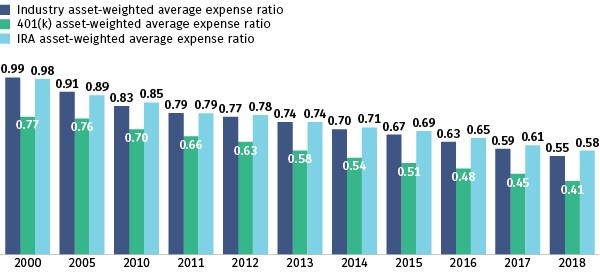
Note: Data exclude mutual funds available as investment choices in variable annuities.
Sources: Investment Company Institute, Lipper, and Morningstar
IRA bond mutual fund assets were 18 percent of IRA mutual fund assets in 2018. Average expense ratios for bond mutual funds held by IRA investors have decreased sharply over the past five years and are down 51 percent from their level in 2000. The average expense ratio paid by bond mutual fund investors in IRAs fell to 0.42 percent, down from 0.46 percent in 2017 and 0.85 percent in 2000 (Figure 3).
Figure 3
Bond Mutual Fund Expense Ratios
Percent
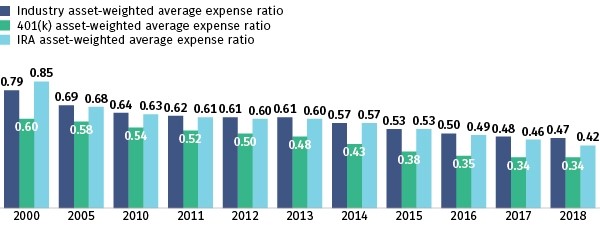
Note: Data exclude mutual funds available as investment choices in variable annuities and tax-exempt mutual funds.
Sources: Investment Company Institute, Lipper, and Morningstar
Twenty-two percent of IRA mutual fund assets were invested in hybrid mutual funds in 2018. Similar to equity mutual funds, average expense ratios for hybrid mutual funds held by IRA investors have fallen for nine consecutive years and are down 33 percent from their level in 2000. The average expense ratio paid by hybrid mutual fund investors in IRAs fell to 0.60 percent, down from 0.62 percent in 2017 and 0.89 percent in 2000 (Figure 4).
Figure 4
Hybrid Mutual Fund Expense Ratios
Percent
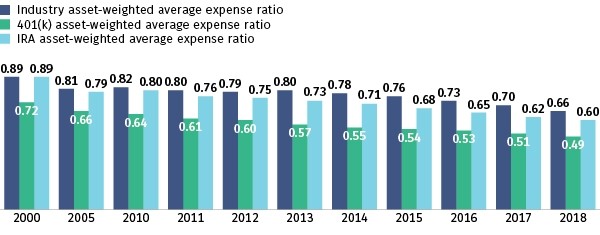
Note: Data exclude mutual funds available as investment choices in variable annuities.
Sources: Investment Company Institute, Lipper, and Morningstar
A Comparison with 401(k) Mutual Fund Investors
The data show that 401(k) investors incur lower expense ratios in their mutual fund holdings than IRA mutual fund investors. One reason for this is economies of scale, as many employer plans aggregate the savings of hundreds or thousands of workers, and often carry large average account balances, which are more cost-effective to service. In addition, employers that sponsor 401(k) plans may defray some of the costs of running the plan, enabling the sponsor to select lower-cost funds (or fund share classes) for the plan.
Another difference: IRA investors often pay for the assistance of a financial professional when investing, and sometimes cover the cost of this service by investing in a fund (or fund share class) that has a 12b-1 fee. This fee, which the fund collects and passes to the financial professional assisting the IRA investor, is included in the fund’s expense ratio. 401(k) plan participants have generally had more limited access to professional financial advice, and so 401(k) plans commonly select funds (or fund share classes) that provide no compensation for financial professionals and thus have somewhat lower expense ratios.
IRA Investors Concentrate Their Assets in Lower-Cost Funds
Like mutual fund assets in 401(k) plans and across the industry, IRA mutual fund assets tend to be concentrated in lower-cost mutual funds. At year-end 2018, 86 percent of equity mutual fund assets held by IRAs were invested in mutual funds with expense ratios of less than 1.00 percent, with 38 percent invested in equity mutual funds with expense ratios of less than 0.50 percent (Figure 5).
Figure 5
Equity Mutual Fund Assets Held in IRAs Are Concentrated in Lower-Cost Funds
Percentage of industrywide, 401(k) plan, and IRA equity mutual fund assets, 2018
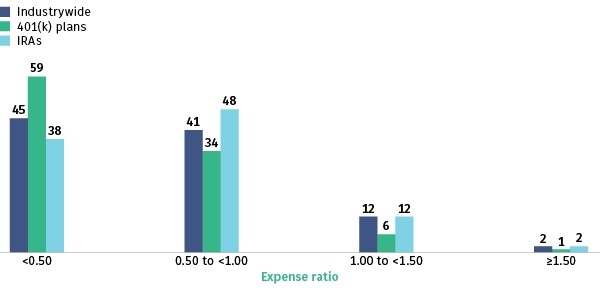
Note: Data exclude mutual funds available as investment choices in variable annuities.
Sources: Investment Company Institute and Morningstar
ICI Methodology
ICI evaluates fee trends using asset-weighted averages to summarize the expenses that shareholders actually pay through funds. To compute the average, ICI weights each fund’s expense ratio by that fund’s end-of-year total net assets. Simple averages (counting each fund’s expense ratio equally) overstate the impact of the expenses of funds in which investors hold few dollars.
Find data on all figures in this report, including additional data on expense ratios between 2000 and 2018, here. For more information about IRAs, visit our Individual Retirement Account Resource Center.
James Duvall is an Economist at ICI.
